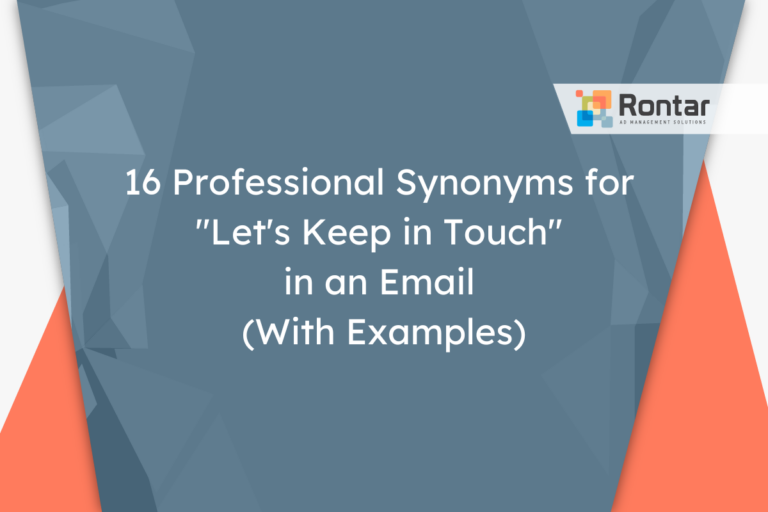Importance Why Acknowledging Emails Matters
In today's fast-paced work environment, acknowledging email receipt is crucial. It confirms the sender's message was received and is being addressed, fostering clear and efficient communication.
This article provides 14 different professional phrases to acknowledge an email, alongside practical usage scenarios and illustrative email examples to guide your responses, making your email interactions smoother and more effective.
Formal 1. Thank you for your email
This is a polite and formal option, appropriate for clients, senior colleagues, and any professional contact. It demonstrates appreciation and respect, signaling that the sender’s message is valued and being taken seriously.
Use it in professional email chains where maintaining a formal relationship is essential. It is an effective way to show gratitude and readiness to engage with the content.
Formal 2. I have received your email
This is a formal and straightforward way to confirm receipt, suitable when you need to acknowledge without providing an immediate response or taking action.
Use it with peers, supervisors, or external parties when an acknowledgment is necessary, but a detailed reply will follow later. It assures the sender their message has been noted.
Polite 3. Thank you
A versatile, polite acknowledgment for both formal and informal settings. It is great for brief replies expressing gratitude quickly without providing excessive details.
Works well with familiar colleagues or in less formal corporate environments. It shows appreciation without making the message too verbose.
Friendly 4. I’ll take a look, thanks
Strikes a balance between informal and polite, ideal for messages with colleagues or in environments that encourage a friendly tone. It acknowledges receipt and indicates a quick review of the request or information.
Ideal for situations where follow-up action is needed from your side.
Direct 5. Noted
A very straightforward and somewhat informal way to acknowledge an email. It suits interactions within teams or with colleagues where you have a casual relationship.
Can come across as brisk, so use it in contexts where brevity is appreciated, and the sender knows your tone is not dismissive.
Clear 6. Understood
Primarily used in informal settings, conveys a clear acknowledgment of the content without formality. It is great for quick exchanges with team members or when responding to instructions.
Communicates the message is clear and needs no further explanation.
Succinct 7. Received
A one-word acknowledgment, very informal and should be reserved for critical communications where brevity is essential and the relationship permits such succinctness.
Use within internal team communications or quick, informal updates. Be cautious of using it in formal correspondence, as it may appear overly terse or indifferent.
Professional 8. Your email was well received
More formal and detailed, it suits professional settings where a thorough acknowledgment is needed. Particularly useful with new clients, external partners, or anyone you're building rapport with.
The addition of “well” adds a polite touch, suggesting not just receipt but appreciation.
“Effective email acknowledgments are a cornerstone of professional communication, demonstrating respect and ensuring clarity.
Expert Insight
Enhance Your Email Skills!
Explore these interactive elements to improve your email communication.
Email Acknowledgment Quiz
Test your knowledge with our interactive quiz! See how well you can match phrases to various email scenarios.
Downloadable Email Templates
Get access to ready-to-use templates to streamline your email responses.
Email Terminology Glossary
Learn essential email terms with our handy glossary.
Balanced 9. Email received
Simpler and slightly less formal, it's straightforward and appropriate in most professional exchanges. It strikes a good balance between acknowledgment and formality, ideal for internal team communications and client emails.
A polished way of confirming you've seen their message without going into detail.
Polite 10. Well received
Comparable to “Your email was well received,” this phrase is polite and formal, suitable for interactions requiring more formality. It is a great choice for new clients, senior management, or external contacts.
The term “well” suggests you value the information shared.
Informal 11. Got it
Very informal and should be used with people you have a casual or comfortable relationship with. Perfect for quick replies among team members or regular colleagues.
Ensure its informality is not misinterpreted as unprofessionalism or disinterest.
Adaptable 12. Acknowledged
A tone that is both formal and informal, it is adaptable to a variety of situations. Short and suggests the message was received and noted. This is suitable for peer and upward reporting, particularly when the conversation is technical or task-based.
Suitable for various communication levels.
Casual 13. Copy that
Informal, with a casual, conversational feel. Mainly used in quick exchanges where both parties are comfortable with each other, often in team environments. Communicates that you've received and understood the message clearly.
Avoid in formal communications because it might seem too casual.
Formal 14. Well noted
Formal and conveys that you have received the message and give it importance. Particularly appropriate for correspondences requiring detailed follow-up or when dealing with external or senior contacts. Indicates the content has been received with the attention it merits.
Demonstrates respect and attention to detail.
Summary Final Thoughts
Choosing the right acknowledgment phrase significantly improves communication. By matching the tone to the situation and the recipient, you ensure smooth and professional interactions.
Use these examples as a guide, customize them as needed, and elevate your email responses.